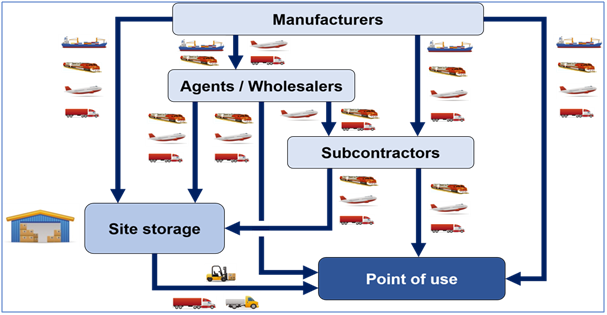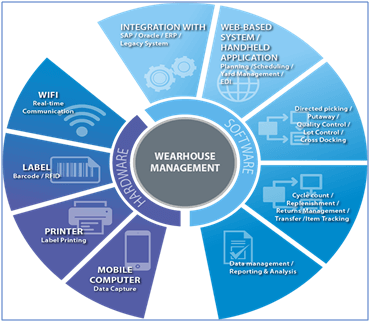Warehouse inventory levels and key customer ordering patterns––and transportation management systems––within which information pertaining to the location of important supply chain assets such as products or vehicles is typically stored. These systems are key factors in integrating the physical flow of goods along the supply chain. The integration of these systems leads to global inventory visibility, which, in turn, leads to reduced costs and improved customer service by decreasing shipping and receiving cycle times, increasing shipment and inventory accuracy, and decreasing lead-time variability. The total cost benefits that can be achieved by suppliers and warehouses through the increased global visibility provided by an integrated system.

Table of Contents
Materials, Components and Equipment for EPC Projects
The large number of materials, components, equipment and services that are required for the construction of a process plant. In this section, we briefly describe the different categories of materials and equipment.

We categorise the materials, components and equipment as follows:
• Bulks: Bulk and generic materials, requiring basic specifications, no pre-delivery checking and limited quality control. Examples include basic building materials like sand, stone, wood, cement and bricks.
• Commodities: Generic equipment, bought to specification following a visit to the suppliers site and requiring active quality control. Examples include structural steel, pipes and pipe fittings, valves, small pumps, cabling, field instruments, etc.;
• Process equipment: This category covers process equipment requiring detailed specifications, astute vendor selection, site visits and quality control. Examples include process vessels, tanks, heat exchangers, columns, and process control equipment;
• Modular plant units: Modular plant units are prefabricated process units designed, built, tested and then delivered to site. Plant modules could be anything from basic pre-assembled pipe-racks (PARs) to third generation plug-and-play modules;
• One-off high-value items: One-off high-value items are typically large high-value and long-lead items built to very strict specifications with continuous quality assurance.
• Construction equipment: Heavy equipment to be used for the construction phase of the project, including cranes, graders, loaders, excavators, forklifts, bulldozers and trucks.
Warehousing
Warehousing is part of a logistics management system, and is a key component for effective management of supply chain. The purpose of warehousing is to store materials and finished goods.The inbound functions prepare items for storage, whereas the outbound functions consolidate, pack and ship orders. The goal of warehousing is to integrate with transportation and ensure on-time delivery of goods. Inbound refers to the flow of materials for storage and handling, as well as transportation requirements to facilitate either manufacturing or market distribution. Outbound refers to the process of storing and moving the final product and related information flows from the end of the production line to the end consumer.
Transportation
Transportation is a key node in the entire supply chain. The activity involves planning, implementing and controlling the forward and reverse flow and storage of goods, and services. Pipe rack module, vessel and concrete components are fabricated off-site or overseas and transported to the site. Thus, constructors are able to save on the materials and cost.

Reasons for Integrated Warehousing and Transportation
1. Greater efficiency
Efficiency in logistics is about meeting deadlines, managing costs and delivering quality. An efficient supply chain depends on timely delivery, highly organised storage and stock management, fast and accurate picking and packing, and shipping of the right goods to the right place at the right time.
So as well as having the physical warehouse capacity and transport infrastructure in place, real efficiency comes from seamlessly integrated systems and management reaching across both warehousing and transportation operations, meaning that cost, reliability and quality guarantees can be met.
2. Faster response times
The single point of contact at warehouse and transportation provider fronts a fully integrated, centrally managed logistics operation.
3. Overall lower costs
Using an integrated warehousing and transportation should result in greater levels of efficiency, better service and less room for failure.It should also translate into lower costs across the board, purely because of the inherent cost efficiencies of integrated systems.
4. Improve customer service
Customer service can be improved through visibility on orders, products and stock, as well as reliable service levels and lead times. This also includes proactive exception management.
5. Realise cost savings
Cost saving can be realised through creation of synergies in the network, consolidation and load optimisation, as well as efficient utilization of logistics resources.
Warehouse Management System (WMS)
A warehouse management system (WMS) is a software application, designed to support and optimize warehouse functionality and distribution center management.

Transportation Management System (TMS)
A transportation management system (TMS) is a subset of supply chain management (SCM) that deals with the planning, execution and optimization of the physical movements of goods. In simpler terms, it’s a logistics platform that enables users to manage and optimize the daily operations of their transportation fleets.
The full content is only visible to SIPMM members
Already a member? Please Login to continue reading.
References
Sivalingam,M. (2018). “8-p-effective-delivery-integrated-logistics-operations”. Retrieved from SIPMM: https://publication.sipmm.edu.sg/8-p-effective-delivery-integrated-logistics-operations, accessed 30/08/2018.
Hassan, H. (2018). “Effective-warehouse-storage-for-shipment-efficiency”. Retrieved from https://publication.sipmm.edu.sg/effective-warehouse-storage-for-shipment-efficiency, accessed 30/08/2018.
Steyn, J.&Lourens, D. (2017). “An Introduction to Project Logistics Management”. Retrieved from http://www.ownerteamconsult.com/an-introduction-to-project-logistics-management, accessed 30/08/2018.
Hayes, B. (2018). “WMS-TMS Integration”. Retrieved from https://www.flo-group.com/wms-tms-integration-whitepaper/, accessed 30/08/2018.
Jeffry, M. (2016). “6-reasons-why-integrated-warehousing-distribution-works”. Retrieved from https://www.linkedin.com/pulse/6-reasons-why-integrated-warehousing-distribution-works-jeffery, accessed 30/08/2018.

